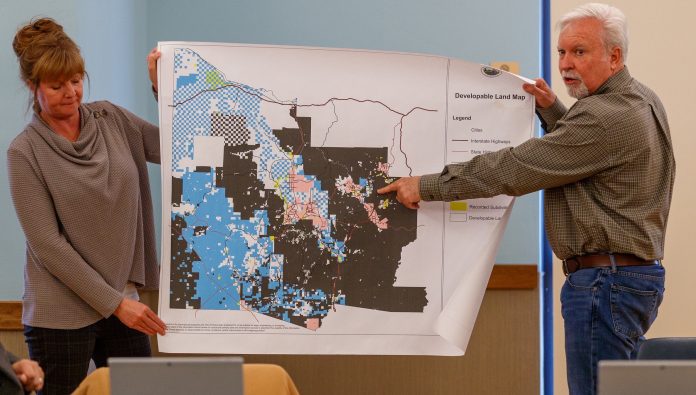Sedona entered into a contract with the firm Elliott D. Pollack and Company in July to do a study on housing needs in the area, costing the city $100,000.
In the fall, Sedona and Elliott D. Pollack offered the other municipalities in the area a chance to be included in a wider study of the whole Verde Valley for a cost of an additional $40,000.
Cottonwood and Camp Verde each kicked in an additional $10,000, Clarkdale paid $4,000 and additional interest came from groups such as NACOG, Yavapai County and the Verde Valley Regional Economic Organization.
On Wednesday, Feb. 12 at the Cottonwood Recreation Center, a group of representatives from Cottonwood, Camp Verde, Clarkdale, Yavapai County, Northern Arizona Healthcare, VVREO, the local Habitat for Humanity chapter and other organizations from the area came together to kick off the joint housing assessment.
Rick Merritt from Elliott D. Pollack started off the conversation with a discussion of the current state of housing and employment in the area. He provided figures gleaned from the American Community Survey and the U.S. Census, though with the early stages of the study having been focused on Sedona, Merritt’s presentation lacked specifics on the other Verde Valley communities.
According to Merritt, just 25.8% of employees in Sedona live in city limits, while the rest commute in. Commutes for Sedona residents average at 16.4 minutes, compared to 25.3 minutes for other Verde Valley communities. In Sedona, 38% of homeowners and 57.9% of renters pay more than 30% towards housing, while in the other communities, 30.8% of owners and 46.6% of renters do. A total of 60% of employees of the city of Sedona who live outside of the city [which represents 62.1% of the city government’s workforce] said that they would move to Sedona if it was more affordable.
Merritt pointed to the rise in short-term rental properties — 744 of them in Sedona — as a major cause of increasing housing costs by disrupting the traditional housing market and increasing the cost of long- term rentals and taking up housing that used to be for families.
“Short-term rentals have become a big issue,” Merritt said. “In Sedona that’s one of the major problems we’re seeing up there, and I think in the last couple years, that’s why housing has risen to a high priority in the city.”
Yavapai County District 2 Supervisor Tom Thurman pointed to the positive qualities of the area that attract residents from places, such as Maricopa County, as raising the demand for housing in the Verde Valley. He also suggested that the booming tourism business in Sedona could be making it hard for residents to afford to live in the area, even if it was bringing in business.
“In 2008 to 2012 we were hurting here,” Thurman said. “Our state parks were closing, our national monuments — nobody was hardly going to them. And we did everything we could in the Verde Valley in order to spike interest for tourism in the Verde Valley, and now it’s gotten to the point where, whoa, did we get what we asked for, to the max? We’ve got to remember that there’s a lot of public land in the Verde that will never be built on, but there’s also a lot of land that can be built on.”
Sheila Harris, a housing consultant who was previously the director of the Arizona Department of Housing and attended the meeting, described the problem in Sedona as the “billionaires kicking out the millionaires.”
The problem of workforce housing was a major focus of many of the participants. Ron Haase, representing Northern Arizona Healthcare, said that the hospital has had even doctors turn down jobs in the area because they were unable to afford housing in the area.
“It’s not easy hiring physicians,” Haase said. “We all think every physician makes a gazillion dollars. Every physician doesn’t earn a gazillion dollars. In fact, those who tend to earn the lowest are the ones that you want to go to and take your children to as well — they’re called family practice physicians. And we wouldn’t apologize for what they make, but when they go out and look for a home — not a mansion — they’re having difficulty finding places they can live. So it’s affecting the whole spectrum of our community.”
Luke Sefton of Sefton Engineering, a local development company, pointed to difficulty in getting building projects approved as a reason for a housing shortage. Several participants brought up the difficulty that the proposed Spring Creek Ranch development between Sedona and Cornville has faced from public opposition.
“If you’re negative to the housing or to expansion, and you’re complaining about the cost of housing, that’s raising the price of housing, because the more [developers] have to go through, and the more difficult for a development to come in, if they’re successful or not successful, then they just add it to the cost of the next project,” Sefton said.
With the housing needs assessment still in its early stages, the meeting did not provide many solutions to the problem. But all of the many participants from various towns and agencies agreed that there is a crisis, and that the valley needs to find a way to give residents more affordable places to live.



